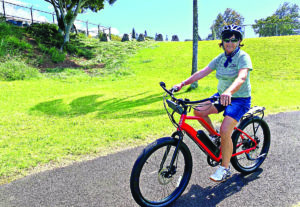Fueled by the pandemic, bicycling in general has experienced a boom. Biking is an ideal way to exercise while socially distancing.
Electric bicycles (e-bikes), much like toilet paper, face masks and hand sanitizer, are another pandemic success story. As Americans emerged from lockdowns, most e-bike companies saw sales skyrocket. While people of all ages buy e-bikes as an eco-friendly, alternative means of transportation, seniors are the largest target market.
E-bikes are revolutionizing cycling for senior adults, allowing us to ride longer, faster and with little or no pain. The low-impact exercise is simply easier on an aging body. With an e-bike, “over-the-hill” boomers can get a little help getting over that hill without injuring muscles and joints.

Health Benefits
Cycling improves cardiovascular health while pumping more blood to the brain, contributing to improved mood. Medical researchers have even discovered that cycling helps alleviate the symptoms of Parkinson’s and Alzheimer’s diseases.
Seniors who bike together also reap social benefits in the safety of the great outdoors. Seniors who live in bike-friendly communities can use e-bikes as regular means of transportation to do shopping and errands.
While riding an e-bike may not be as intense a workout as riding a regular bike, users are much more likely to ride longer and more often, because the e-bike experience is more enjoyable.
How an E-bike Works
E-bikes are conventional bicycles with assistive superpowers. Riders use gears and pedals most of the time, just like with a traditional bike, but have the option to give themselves a boost, thanks to a rechargeable lithium-ion battery-powered motor. The small motor can be engaged to help you whiz up hills and battle head winds more easily.
Buying an E-Bike
Just like traditional bikes, different models of e-bikes are available depending on the rider’s needs. The most popular styles for seniors are cruiser bikes, trikes and recumbents. E-bikes are more complicated and expensive than conventional bicycles, so you need to do your research.
There are three classes of e-bikes: Pedal-assist electric bikes provide assistance only when the rider is pedaling and only up to 20 mph. Throttle-assist e-bikes let you use the motor without pedaling, also up to 20 mph. Speed pedal-assist e-bikes are similar to pedal-assist bikes, except the motor will assist with speeds of up to 28 mph.
The average e-bike weighs about 50-plus pounds. Prices vary widely, starting at about $1,000 and going as high as $12,000.
Find a bike shop in your area so you can test-ride a few and begin rolling back the years!
For information about Hawai‘i’s e-bike laws, visit http://bit.ly/HawaiiE-bikeLaws.


Leave a Reply